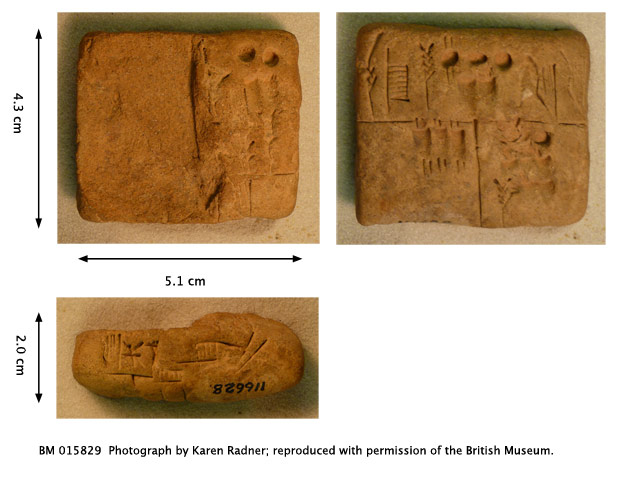BM 116628: proto-cuneiform administrative text about barley

BM 116628: administrative text about barley (from Jemdet Nasr, Uruk III period, c. 3000 BC). Photograph by Karen Radner; reproduced with permission of the British Museum. View large image.
The world's earliest known writing comes from the ancient city of Uruk PGP , in Iraq. Several systems for meeting the complex administrative needs of large urban households were in use in the late fourth millennium BC. A new system — the form of writing known as proto-cuneiform — soon proved itself more effective than all the others.
This tablet illustrates some of the key characteristics of proto-cuneiform. The signs are representations of objects, parts of human or animal anatomy or the like. On this tablet you can see the signs for HAND, BARLEY and round numerical characters among others. The signs are made up of a combination of straight lines and curves drawn with a pointed tool.
Many early tablets seem to be concerned with issuing subsistence rations to workers, as indicated by the compound sign HEAD+BOWL. While the meaning of the archaic texts would have been quite transparent to the Uruk scribes, their interpretation is more problematic for the modern reader. It is not always clear what the meaning of the signs is supposed to be, and sometimes the nature of the transaction as a whole is unclear. Rulings on the tablet divide the signs into meaningful groupings; the location of information on the tablet helped to convey its meaning.
For more online photos, view the record for this tablet on the British Museum's research database [http://www.britishmuseum.org/research/search_the_collection_database.aspx].
A transliteration of the text can be found in Englund & Grégoire, MSVO 1 (1991), no. 30.
Content last modified on 31 Mar 2025.
Jon Taylor
Jon Taylor, 'BM 116628: proto-cuneiform administrative text about barley', Knowledge and Power, Higher Education Academy, 2025 [http://oracc.museum.upenn.edu/saao/knpp/CuneiformRevealed/Tabletgallery/BM116628/]